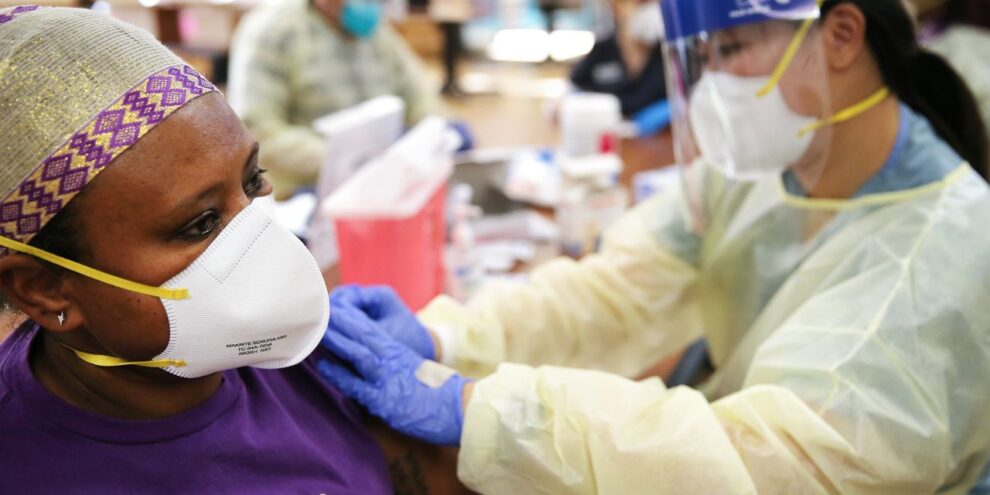
As the pace of COVID-19 vaccinations in the U.S. lags, a recent analysis of data in 16 states shows that Black people are getting immunized at lower rates than their white counterparts.
The share of Black people who have been vaccinated against the deadly disease — which has taken a disproportionate toll on people of color — is far lower than the share of vaccinated white people in several states, according to a Kaiser Health News analysis of state health-department data that reported vaccine recipients’ race and ethnicity.
In Pennsylvania, the share of white residents who had gotten their COVID-19 shot as of Jan. 14 was 1.2%, versus 0.3% of Black residents, according to the report. In Mississippi, the white vaccination rate was 3.5%, compared to 1.3% among Black residents; in Florida, the vaccination rates were 3.1% among white people versus 1.1% among Black people.
White people in North Carolina, Nebraska, Indiana, Maryland, Alaska, Ohio, Tennessee, Missouri and Oregon, the other states that reported race separately from ethnicity, were also vaccinated at higher rates than Black people, the analysis found. The disparity was lowest in Oregon, however, with a white vaccination rate of 2.4% and Black vaccination rate of 2.3%.
In the states analyzed, the share of vaccine recipients who are Black fell short of the share of Black residents in the state. It was also much lower than the share of health workers who are Black, a relevant data point given that workers in health-care settings have been prioritized for limited vaccine doses alongside long-term-care facility residents.
The report suggested that this racial disparity in health-care worker vaccinations stemmed from both barriers to access and lack of trust in the medical establishment. Experts have traced vaccine hesitancy in minority communities not just to a history of medical racism and experimentation — most prominently the Tuskegee syphilis experiment — but also present-day racial injustices.
“It’s the daily experiences that people are having that leads them to distrust the government,” Monica Peek, a University of Chicago associate professor of medicine who researches health disparities, previously told MarketWatch. “Be that health care, education, protection from the police, equal justice from our criminal-justice system, you name it: Are we treated fairly, and are our lives valued, and are we given things that are there to protect us and to save our lives?”
A survey published in December by the Kaiser Family Foundation, a health-care think tank from which Kaiser Health News operates independently, found additional reasons for vaccine hesitancy.
Among the 35% of Black adults who said they wouldn’t get a COVID-19 vaccine, the top reasons cited were concerns about potential side effects (71%), the vaccine’s newness and their intent to wait and see how it works for other people (71%), and lack of trust in the government to make sure the vaccine is safe and effective (58%).
As the country on Tuesday registered 400,000 COVID-19 deaths to date, Centers for Disease Control and Prevention data last updated Nov. 30 showed that Black Americans are 3.7 times as likely as white Americans to be hospitalized with COVID-19 and 2.8 times as likely to die.
Hispanic people are 4.1 times as likely to be hospitalized and 2.8 times as likely to die; Native American people are 4 times as likely to be hospitalized and 2.6 times as likely to die; and Asian Americans are 1.2 times as likely to be hospitalized and 1.1 times as likely to die, according to the health agency.
Black and Hispanic people aren’t “inherently more susceptible” to COVID-19 illness and mortality, a recent study suggested — rather, “existing structural determinants” appear to drive the health disparities.
The CDC, for example, says that an array of social determinants of health place many people of color at heightened risk for poor COVID-19 outcomes, including disparities in health-care coverage and access; disproportionate representation in “essential” jobs that often carry greater virus-exposure risk; crowded housing conditions; and disparities in income, education and wealth.
Coronavirus vaccines from Pfizer PFE, -0.63% and its German partner, BioNTech BNTX, -1.40%, and Moderna MRNA, +0.10% in December became the first two candidates to receive emergency-use authorization from the U.S. Food and Drug Administration. Other vaccines could eventually be made available as well.
As of Friday, nearly 12.3 million total COVID-19 vaccine doses had been administered in the U.S., according to the CDC: Almost 10.6 million people had received one or more doses, and 1.6 million people had received two doses. In total, at least 31.1 million doses had been distributed.
While the U.S. vaccine rollout has proceeded behind schedule, National Institute of Allergy and Infectious Diseases director Anthony Fauci earlier this month called President-elect Joe Biden’s target of 100 million vaccinations in his presidency’s first 100 days a “very realistic” and “achievable” goal. He said he believed that earlier “glitches” in the United States’ mass-vaccination program had since been resolved.






